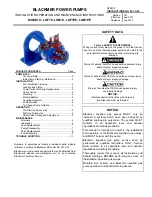
Installation
Each Danfoss Heat Pump scroll compressor is shipped with printed Instructions for installation.
Compressor handling and
storage
Compressor holding
charge
Compressors are provided with a lifting lug. This
lug should always be used to lift the compressor.
Once the compressor is installed, the lifting
lug should never be used to lift the complete
installation. The compressor must be handled
with caution in the vertical position, with a
maximum inclination of 15° from vertical. Store
the compressor between -35°C and 50°C, not
exposed to rain or corrosive atmosphere.
Each compressor is shipped with a nominal dry
nitrogen holding charge between 0.4 bar and
0.7 bar, and is sealed with elastomer plugs. The
plugs should be removed with care to avoid
oil loss when the holding charge is released.
Remove the suction plug first and the discharge
plug afterwards. The plugs shall be removed only
just before connecting the compressor to the
installation in order to avoid moisture entering
the compressor. When the plugs are removed, it
is essential to keep the compressor in an upright
position to avoid oil spillage.
System cleanliness
The refrigerant compression system, regardless
of the type of compressor used, will only provide
high efficiency and good reliability, along with a
long operating life, if the system contains solely
the refrigerant and oil it was designed for. Any
other substances within the system will not
improve performance and, in most cases, will be
highly detrimental to system operations.
The presence of non-condensable substances
and system contaminants, such as metal
shavings, solder and flux, have a negative
impact on compressor service life. Many of these
contaminants are small enough to pass through a
mesh screen and can cause considerable damage
within a bearing assembly. The use of highly
hygroscopic POE and PVE oils in R407C and R410A
compressors requires that the oil be exposed to
the atmosphere just as little as possible.
System contamination is one of main factors
affecting equipment reliability and compressor
service life. It is important therefore to take
system cleanliness into account when assembling
a refrigeration system.
During the manufacturing process, circuit
contamination may be caused by:
• Brazing and welding oxides,
• Filings and particles from the removal of burrs
in pipe-work,
• Brazing flux,
• Moisture and air.
Consequently, when building equipment and
assemblies, the following precautions must be
taken: never drill holes into the pipe-work after
installation.
Compressor mounting
Maximum inclination from the vertical plane,
while operating must not exceed 7 degrees.
All compressors are delivered with 4 rubber
grommets and metal sleeves. Compressors must
always be mounted with these grommets.
Brazing material
For copper suction and discharge fittings, use
copper-phosphorus brazing material. Sil-Fos® and
other silver brazing materials are also acceptable.
If flux is required for the brazing operation, use
coated rod or flux core wire. To avoid system
contamination, do not brush flux on.
Tube brazing procedure
Do not bend the compressor discharge or suction
lines or force system piping into the compressor
connections, because this will increase stresses
that are a potential cause of failure. Recommended
brazing procedures and material, are described
on following page.
24
FRCC.PC.017.A2.02
Application Guidelines
















































